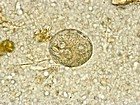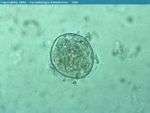Difference between revisions of "Balantidium"
| (7 intermediate revisions by 3 users not shown) | |||
| Line 1: | Line 1: | ||
| − | {{ | + | {{OpenPagesTop}} |
| + | {{Taxobox | ||
| + | |name =''Balantidium'' | ||
| + | |phylum =Ciliophora | ||
| + | |class =Litostomatea | ||
| + | |order =Vestibuliferida | ||
| + | |family =Balantiididae | ||
| + | |genus =Balantidium | ||
| + | }} | ||
| + | |||
[[Image:Balantidium pig.jpg|thumb|right|150px|''Balantidium'' from a pig - Joaquim Castellà Veterinary Parasitology Universitat Autònoma de Barcelona]] | [[Image:Balantidium pig.jpg|thumb|right|150px|''Balantidium'' from a pig - Joaquim Castellà Veterinary Parasitology Universitat Autònoma de Barcelona]] | ||
| Line 5: | Line 14: | ||
| − | ''Balantidium'' is a ciliate protozoan found as a commensal in the lumen of the [[Large Intestine - Anatomy & Physiology|large intestine]]. It infects pigs and other animals, including humans. It is the only ciliate known to be pathogenic. | + | ''Balantidium'' is a ciliate [[:Category:Protozoa|protozoan]] found as a commensal in the lumen of the [[Large Intestine - Anatomy & Physiology|large intestine]]. It infects pigs and other animals, including humans. It is the only ciliate known to be pathogenic. |
==Identification== | ==Identification== | ||
| Line 23: | Line 32: | ||
*''B.coli'' | *''B.coli'' | ||
:This species is the cause of [[Balantidiasis]], which is pathogenic in humans. | :This species is the cause of [[Balantidiasis]], which is pathogenic in humans. | ||
| + | |||
| + | |||
| + | {{Learning | ||
| + | |flashcards = [[Protozoa_Flashcards#Other_Important_Protozoa|Protozoa Flashcards]] | ||
| + | |literature search =[http://www.cabdirect.org/search.html?rowId=1&options1=AND&q1=Balantidium&occuring1=title&rowId=2&options2=AND&q2=&occuring2=freetext&rowId=3&options3=AND&q3=&occuring3=freetext&x=33&y=9&publishedstart=yyyy&publishedend=yyyy&calendarInput=yyyy-mm-dd&la=any&it=any&show=all ''Balantidium'' publications] | ||
| + | }} | ||
==References== | ==References== | ||
Melhorn, H. Encyclopedia Reference of Parasitology. Second Edition. Spring, 2001. Volume I | Melhorn, H. Encyclopedia Reference of Parasitology. Second Edition. Spring, 2001. Volume I | ||
| + | |||
| + | |||
| + | {{review}} | ||
| + | |||
| + | {{OpenPages}} | ||
[[Category:Miscellaneous Protozoa]] | [[Category:Miscellaneous Protozoa]] | ||
| − | + | ||
| − | [[Category: | + | [[Category:Expert_Review]] |
Latest revision as of 16:34, 5 July 2012
| Balantidium | |
|---|---|
| Phylum | Ciliophora |
| Class | Litostomatea |
| Order | Vestibuliferida |
| Family | Balantiididae |
| Genus | Balantidium |
Balantidium is a ciliate protozoan found as a commensal in the lumen of the large intestine. It infects pigs and other animals, including humans. It is the only ciliate known to be pathogenic.
Identification
Balantidium can be identified by their ciliary organelles on their surface membrances. They are 80μm long and have funnel-shaped depressions leading to the cytostome (mouth). Balantidium has two nuclei, one kidney shaped macronucleus and one small micronucleus. Balantidium also has contractile and food vacuoles, which is rare in parasitic protozoa.
Life Cycle
The host ingests a cyst which passes to the small intestine and undergoes encystation to produces trophozoites. The trophozoites remain in the intestinal lumen and reproduce by binary fission. They are then released with the faeces and encyst to form new cysts. The cysts are thick-walled, ensuring infection of a new host.
Pathogenesis
Pigs are common resevoirs of Balantidium coli. It is usually found as a commensal, but may cause ulceration and dysentery if the intestinal mucosa is damaged already as the parasite will become invasive. Infected pigs shed vast numbers of cysts in their faeces. Human infection can occur via consuming contaminated foodstuffs and contact with infected pig faeces. It causes ulceration and dysentery.
Important Species
- B.coli
- This species is the cause of Balantidiasis, which is pathogenic in humans.
| Balantidium Learning Resources | |
|---|---|
 Test your knowledge using flashcard type questions |
Protozoa Flashcards |
 Search for recent publications via CAB Abstract (CABI log in required) |
Balantidium publications |
References
Melhorn, H. Encyclopedia Reference of Parasitology. Second Edition. Spring, 2001. Volume I
| This article has been peer reviewed but is awaiting expert review. If you would like to help with this, please see more information about expert reviewing. |
Error in widget FBRecommend: unable to write file /var/www/wikivet.net/extensions/Widgets/compiled_templates/wrt6934dea68881b8_14200627 Error in widget google+: unable to write file /var/www/wikivet.net/extensions/Widgets/compiled_templates/wrt6934dea6918649_90491049 Error in widget TwitterTweet: unable to write file /var/www/wikivet.net/extensions/Widgets/compiled_templates/wrt6934dea6985aa3_13633833
|
| WikiVet® Introduction - Help WikiVet - Report a Problem |

